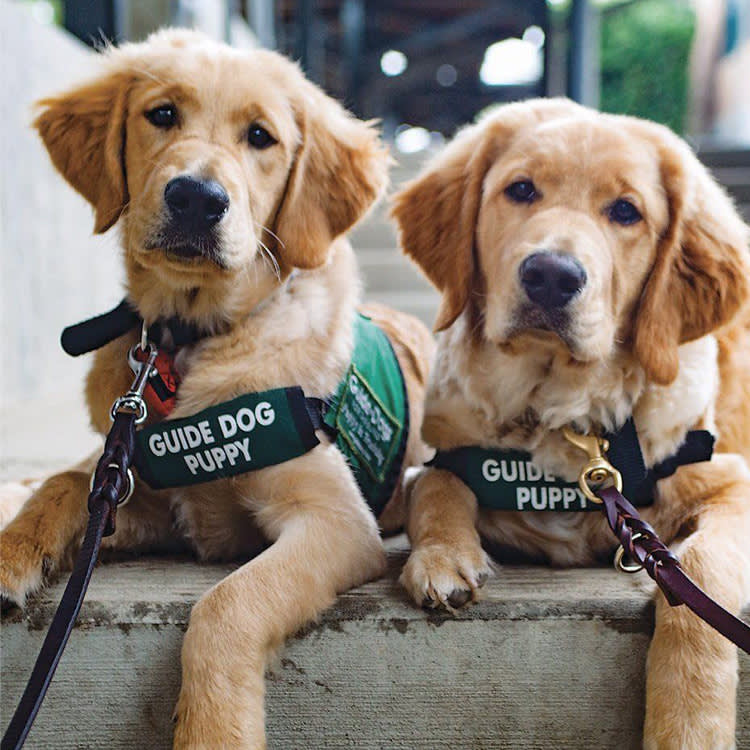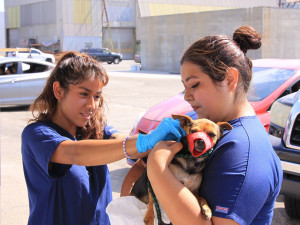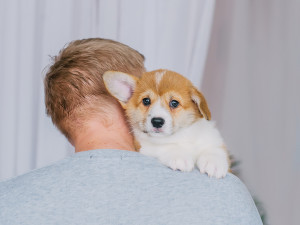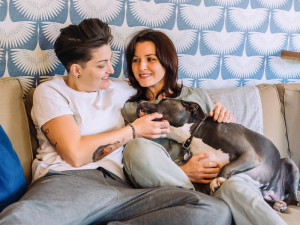What it’s Like to Raise a Guide Dog Puppy
A volunteer with Guide Dogs for the Blind shares her experience.

share article

Your pet wants you to read our newsletter. (Then give them a treat.)
After her Labrador Retriever died, Jenny Collins, who lives in Portland, Oregon, was devastated. Knowing she wasn’t ready to bring another dog into her life, she decided to volunteer with dogs as a way to help fill the void. She quickly found the perfect match: Guide Dogs for the Blind (GDB)opens in a new tab, a nonprofit organization created in 1942 to breed, train, and pair service dogs with visually impaired people to help them achieve greater safety, mobility, and independence.
Provided free of charge to the client, each dog represents a $100,000 investment over their lifetime, a cost that is funded 100% by private donations. GDB provides all services free of charge to their clients, including the cost of transportation and room and board while they undertake two weeks of training with their new guide dogs, annual visits, an alumni association, and veterinary care. If issues arise, the organization provides an instructor or field manager to help resolve them.
The transformation of GDB’s carefully bred puppies — Labrador Retrievers, Goldens, and Lab/Golden mixes — into reliable service dogs depends heavily on the raisers who start each new puppy on their long path toward training and graduation as a service dog.
How GDB Puppy Raising Begins
Staff and volunteers help the canine moms raise their litters through the first eight weeks at the organization’s San Rafael, California campus. At two months old, the puppies are ready to go to individual homes. Most are transported to the various locations where volunteer raisers meet their puppies for the first time. After roughly a year in a home environment in which a clearly defined protocol is followed, the young dogs go into formal training at a GDB campus in California or Oregon.
Not surprisingly, given the nature of the work, volunteers are thoroughly vetted by GDB, including a home visit to meet everyone involved and make sure the setting is pet-safe. “The puppies need consistency from their raisers,” Collins says. “So [the raisers] need to attend the training meetings, read all the documents, and watch the videos. It’s probably a 40-hour commitment before taking in your first puppy.”
Typically, a new volunteer eases into the work by acting as a puppy sitter for dogs of varying ages and training stages. “We want to set people up for success,” Collins says, “to let them see what it’s like to have a puppy in their home before they commit to becoming a puppy raiser.”
For Collins personally, it was two months before she was eligible to do anything hands-on with a puppy, and she recalls being frustrated because she was so eager to jump in. In retrospect, she understands why the more careful approach is necessary, and that raisers’ experience may vary, as many puppy sitters do hands-on work at meetings. Even now, Collins admits that she has questions and doubts about what she’s doing.
In some cases — like Collins’, because she works full-time — a puppy raiser partners with a puppy starter, who takes the two-month old for eight weeks and oversees most of their early basic training while finishing the vaccination schedule that started at the San Rafael campus. “I’m grateful beyond words for the puppy starter families because otherwise, I could not do this,” says Collins.
There are 180-plus GDB puppy raising clubs across 10 western states: Arizona, California, Colorado, Idaho, Nevada, New Mexico, Oregon, Texas, Utah, and Washington. Each of those states has at least one club, and new volunteers must join a club in order to become a puppy raiser. Puppy raisers are responsible for teaching the puppies good manners and providing socialization experiences for about the first year of the pups’ lives. They commit to attending twice-monthly meetings with the puppy for foundational training and support, and, once or twice each month, to taking the puppy on socialization outings to places where guide dogs might eventually work including malls, grocery stores, public transportation, and restaurants, which is Collins’ favorite part.
“I volunteer to help coordinate outings since I love being a ‘social director,’” she says. She managed to get donated tickets to a minor-league baseball game so several puppy raisers and their pups could attend. Another time, she arranged a transit outing, creating a loop where the puppy raisers and their dogs rode an aerial tram, street car, light rail, and a bus.
Inside the Puppy Raising Experience
The first GDB puppy Collins raised was named Fizzy, and she came to Collins when she was four months old after spending time with a puppy starter family.
Collins says that when she first joined her puppy raising club, she didn’t have any interest in sharing the task with a co-raiser. “I wanted to be independent in this, and so I was reluctant at first to share. But the more I learned about what was involved in raising one of these puppies, it became apparent that co-raising — for me and most people, and for the dog — is highly beneficial.”
To “co-parent,” Collins found a compatible family within her club. During Fizzy’s year-long training, she swapped homes every Tuesday. “I would take Fizzy to work with me on Monday and Tuesday, hand her off to the other family, and have the rest of the week and weekend off,” she explains. “The next week, no puppy on Monday and Tuesday, then Wednesday through Friday I’d bring her to work, have her over the weekend, take her to work the next Monday and Tuesday, and so on. It allowed me to schedule work obligations for when I didn’t have Fizzy. And it was like having a built-in puppy sitter if I was going out of town for a weekend. I did the same for my co-raiser family. It ended up working out pretty evenly over the year we had Fizzy.”
Collins adds that raising a puppy is demanding, especially during the early weeks, when they’re high-energy and prone to chewing everything in reach. When Fizzy was with her at work, she was tethered in her workspace with a bed, bowl of water, and chew toys, but didn’t have access to the entire office. Puppies are gradually given freedom at home so that by the time they return to a GDB campus for formal training, they can be trusted alone in one or two rooms for up to an hour.
Toys, House Training, and Commands
Raising a GDB puppy isn’t like raising a family pet. If they pass all their training successfully, these puppies will have great responsibilities. They need to be calm, ignore distractions, and remain focused on their human, keeping them safe from harm. They’re not allowed to play fetch — in fact, there are no balls in their toy box because as adults, they can’t be distracted by things that move fast in front of them. Instead, they burn off their energy with games of tug and sturdy chew toys.
One of the bigger challenges, Collins says, is house training, because accidents take pups out of the guide dog running. “We train them to relieve on command, on leash, and only on hard surfaces,” she explains, adding that she uses a patio in her backyard. “It’s a skill, building toward working as a guide dog. If we go on walks, they’re brief, and only after the dog has relieved at home beforehand. If they don’t, we won't go for the walk.”
Puppy raisers use a specific command to teach a puppy that it’s time to go to the bathroom. They also take their guide-dog-in-training vest off, another signal that they’re not “working” and it’s okay to relieve themselves. Far more than a matter of convenience, this training ensures that, as adult working dogs matched with visually impaired humans, they won’t lose their focus because they’re searching for a place to go, or confuse their human by moving off the intended path to do their business.
In addition to teaching appropriate relieving, volunteers help the pups learn basic commands such as “sit,” “down,” “stand,” “wait,” “stay,” “come,” “go to bed,” “let’s go,” and “that’s enough,” (meaning, we’re done playing).
Collins says there’s no “leave it” command, which she initially found surprising, because her Lab Patience would scarf up all sorts of nasty things if she didn’t see them first. But as she discovered, that particular command isn’t required. Instead, the puppies are trained to completely ignore things on the ground by rewarding them with kibble when they do. They practice this skill until they’re reliable.
In the past, puppy raisers were not allowed to reward the puppies with food. It was important that as working dogs, they were not vulnerable to distraction. Over time, GDB’s training techniques have evolved to include making greater use of food as positive reinforcement. Now, puppies can be rewarded with a piece of kibble, but only the same kibble they eat at meals and only by hand from the person holding their leash.
While raising a puppy, volunteers allow them a little bit of canine interaction, but most contact is with other GDB puppies during those twice-monthly club meetings, where they work on proper dog greetings (sniffing only). They don’t go to off-leash dog parks or greet strange dogs on the street. However, some puppy raisers and parents have other pet dogs in the home (or maybe even a retired guide dog), and in those situations, the puppies can play in controlled ways with the older dog.
“We make sure the puppies have some exposure to other dogs,” Collins says, including occasionally trading puppies within the club so one who hasn’t spent time with a pet dog or cat gets the chance.
When GDB Puppy Raising Doesn't Work Out
When a GDB dog is found to be not well-suited as a working guide dog, GDB tries to match them with one of their partner organizations including Dogs for Better Lives, Dogs for Diabetics, and Paws Assisting Veterans. GDB also has an internal program for career-changed dogs known as K-9 Buddy, which partners dogs with visually impaired children and teenagers not yet ready for the responsibility of caring for a dog themselves.
If none of these programs are a good fit, the dog’s puppy raiser is given the option to adopt. If they choose not to, GDB has an adoption program that places the dogs in loving families looking for potential therapy dogs or amazing pets. GDB receives more than 2,000 applications for the roughly 170 dogs who are career-changed each year. If for any reason a pet parent or client can no longer care for a GDB dog, the organization takes the dog back and finds another home. Ultimately, each GDB dog is guaranteed a good home for a lifetime.
The Rewards Of Saying Goodbye to a GDB Puppy
GDB knows how difficult it can be for puppy raisers to say goodbye to their dogs, so they try to make it easier with an event called a Recall Reception. For Fizzy, Collins met her co-raisers at the facility and together, they checked Fizzy in, settled her in her kennel, and talked to the employees who would care for her.
“It was hard to leave,” Collins remembers. “Walking away, I felt like we were abandoning her. It’s crazy to feel that way. It’s not my decision, it’s what I signed up for.” The facility provides puppy raisers with weekly updates through all eight phases of their dog’s training.
After training, puppy raisers are given an opportunity to meet the client matched with the dog they helped raise. “GDB will give the client your contact info,” Collins says. “The client gets to decide whether to stay in touch or not, so you might never hear.” Dogs can be placed anywhere in the U.S. or Canada, which makes the chance that puppy raisers will randomly see the puppies they raised very slim.
As Collins currently co-raises Fan, she’s realistic about what lies ahead. “I’m not an overly emotional person. Well, except for dogs,” she says, laughing. “I keep telling myself — assuming Fizzy makes it and becomes a guide dog — that this temporary time of sadness and loss is so worth her changing someone’s life. We live in a tough, often negative world, and this is something positive, a gift to a complete stranger. It’s rewarding, but the end goal has nothing to do with me. It benefits someone I’ve never met. How many times in life do you get a chance to give a gift like that? The reward is in making a positive change in a life. Even if Fizzy doesn’t become a guide dog, she’s already changed my life. Now, I hope she’ll change someone else’s.”
Want to Be a Puppy Raiser?
Watch The Pick of the Litteropens in a new tab, a documentary that follows five puppies through the 18-month process of raising, formal training, and graduation, and visit Guide Dogs for the Blindopens in a new tab.

Rebecca Wallick, J.D.
Rebecca Wallick, was long-time contributing editor for The Bark magazine and retired family law attorney, she lives with two dogs and runs mountain trails at every opportunity.
Related articles
![Two veterinarians help a dog through Downtown Dogs Rescue]() opens in a new tab
opens in a new tabDowntown Dog Rescue is Helping Dogs Stay Out of Shelters
Working to keep low-income and homeless people and their pets together.
![Backlit photo of a woman seated on an airplane holding her dog in her lap while they both look out of the open window.]() opens in a new tab
opens in a new tabYou Can’t Fly With Your Your ESA, But Your PSD Is Welcome on a Plane
Find out how here, including what the heck those acronyms mean.
![Person holding a corgi, shot from behind]() opens in a new tab
opens in a new tabFlying with An Emotional Support Animal
Are ESA alpacas and peacocks mocking people with real disorders? A service-dog owner and flight attendant get real.
![Happy lesbian couple cuddling on the couch with pet dog]() opens in a new tab
opens in a new tabGuess Which Shelter Dogs Make Great Service Dogs
Loyal, devoted, and dutiful, Pit Bulls are proving to be pretty well suited to helping humans in need.





